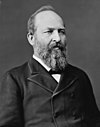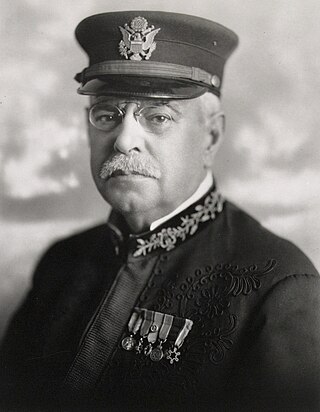
John Philip Sousa was an American composer and conductor of the late Romantic era known primarily for American military marches. He is known as "The March King" or the "American March King", to distinguish him from his British counterpart Kenneth J. Alford. Among Sousa's best-known marches are "The Stars and Stripes Forever", "Semper Fidelis", "The Liberty Bell", "The Thunderer", and "The Washington Post".

James Abram Garfield was the 20th president of the United States, serving from March 1881 until his death the following September after being shot by an assassin in July. A preacher, lawyer, and Civil War general, Garfield served nine terms in the United States House of Representatives and is the only sitting member of the House to be elected president. Before his candidacy for the presidency, he had been elected to the U.S. Senate by the Ohio General Assembly—a position he declined when he became president-elect.
"The Liberty Bell" (1893) is an American military march composed by John Philip Sousa.
"Hail to the Chief" is the personal anthem of the president of the United States, adapted by James Sanderson from an original Scottish Gaelic melody.
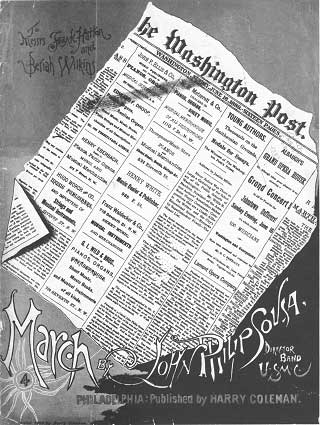
"The Washington Post" is a march composed by John Philip Sousa in 1889. Since then, it has remained as one of his most popular marches throughout the United States and many other countries.
In memoriam is a Latin phrase equivalent to "in memory (of)", referring to remembering or honouring a deceased person.

The United States Marine Band is the premier band of the United States Marine Corps. Established by act of Congress on July 11, 1798, it is the oldest of the United States military bands and the oldest professional musical organization in the United States. Today, the Marine Band includes the Marine Chamber Orchestra and Marine Chamber Ensembles.

The United States Navy Band, based at the Washington Navy Yard in Washington, D.C., has served as the official musical organization of the U.S. Navy since 1925. The U.S. Navy Band serves the ceremonial needs at the seat of U.S. government, performing at presidential inaugurations, state arrival ceremonies, state funerals, state dinners, and other significant events.
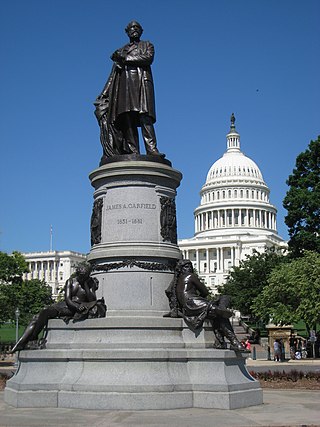
The James A. Garfield Monument stands on the grounds of the United States Capitol in the traffic circle at First Street and Maryland Avenue SW in Washington, D.C. It is a memorial to U.S. President James A. Garfield, who was elected in 1880 and assassinated in 1881 after serving only four months of his term. The perpetrator was an attorney and disgruntled office-seeker named Charles J. Guiteau. Garfield lived for several weeks after the shooting, but eventually succumbed to his injuries. The monument is part of a three-part sculptural group near the Capitol Reflecting Pool, including the Peace Monument and the Ulysses S. Grant Memorial in Union Square. The monument is also a contributing property to the National Mall and L'Enfant Plan, both of which are listed on the National Register of Historic Places and the District of Columbia Inventory of Historic Sites. The bronze statue rests on a granite pedestal that features three sculptures, each one representing a time period in Garfield's life.

Stars and Stripes Forever is a 1952 American Technicolor film biography of the late-19th-/early-20th-century composer and band leader John Philip Sousa. This 20th Century Fox feature was produced by Lamar Trotti, directed by Henry Koster, and stars Clifton Webb, Debra Paget, Robert Wagner, and Ruth Hussey. The film's title is taken from Sousa's "The Stars and Stripes Forever", which has become the best known of his military marches. The film was released twenty years after Sousa's death.

James A. Garfield, the 20th president of the United States, was shot at the Baltimore and Potomac Railroad Station in Washington, D.C., at 9:30 am on Saturday, July 2, 1881. He died in Elberon, New Jersey, two months later on September 19, 1881. The shooting occurred less than four months into his term as president. Charles J. Guiteau was convicted of Garfield's murder and executed by hanging one year after the shooting.

The inauguration of James A. Garfield as the 20th president of the United States was held on Friday, March 4, 1881, at the East Portico of the United States Capitol in Washington, D.C. This was the 24th inauguration and marked the commencement of the only four-year term of James A. Garfield as president and Chester A. Arthur as vice president. Garfield was assassinated 199 days into this term, and Arthur ascended to the presidency. Chief Justice Morrison Waite administered the presidential oath of office.

At 2:15 a.m. Eastern Time on September 20, 1881, Chester A. Arthur was inaugurated the 21st president of the United States. The inauguration marked the commencement of Chester A. Arthur's only term as president. The presidential oath of office was administered by New York Supreme Court Justice John R. Brady at Arthur's private residence in New York City. Two days later, Arthur took part in a second inauguration in Washington, D.C., with the oath administered by Morrison Waite, the Chief Justice of the United States. Arthur became president following the death of his predecessor James A. Garfield, who had been assassinated by a troubled office seeker, Charles J. Guiteau.

"Semper Fidelis", written in 1888 by John Philip Sousa, is regarded as the official march of the United States Marine Corps. This piece was one of two composed in response to a request from United States President Chester A. Arthur for a new piece to be associated with the United States President. The words semper fidelis are Latin for "always faithful." The piece was created for a wind band in addition to a percussion section. There is a very prominent drum solo in the middle of the piece which includes a skillful dynamic change. It features staccato notes and sharp tonguing.
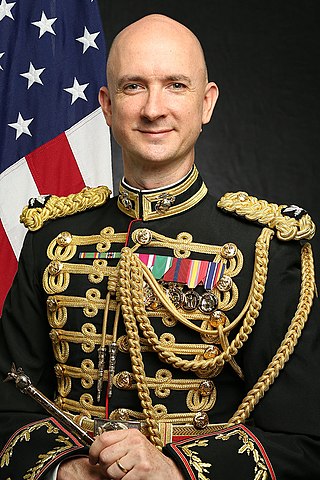
Jason K. Fettig is a band director, conductor, and former Marine colonel who currently works as Director of Bands at the University of Michigan. Before his hiring, he served as the 28th director of the United States Marine Band and music adviser to the President of the United States.

The John Philip Sousa Baton is a conducting baton originally presented to John Philip Sousa upon his resignation as the director of the United States Marine Band. After his death, it was donated to the Marine Band, and since it has been traditionally passed to the new director from the outgoing director of the band during the change of command ceremonies.

Stephen Bulla is an American composer and musician best known compositions for the United States Marine Band and The Salvation Army.
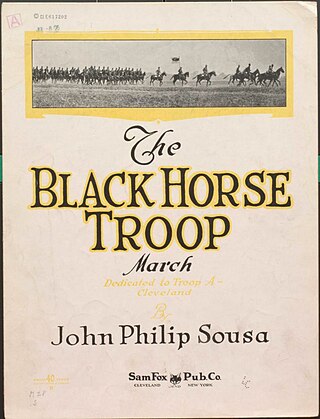
"The Black Horse Troop" is an American military march composed by John Philip Sousa in 1924 and published in 1925. It was dedicated to Troop A - Cleveland of the Ohio National Guard, today the 107th Cavalry Regiment. Sousa's first connection with Troop A was in 1881, when he marched with the unit as leader of the U.S. Marine Band in the funeral cortege of President James A. Garfield.

















